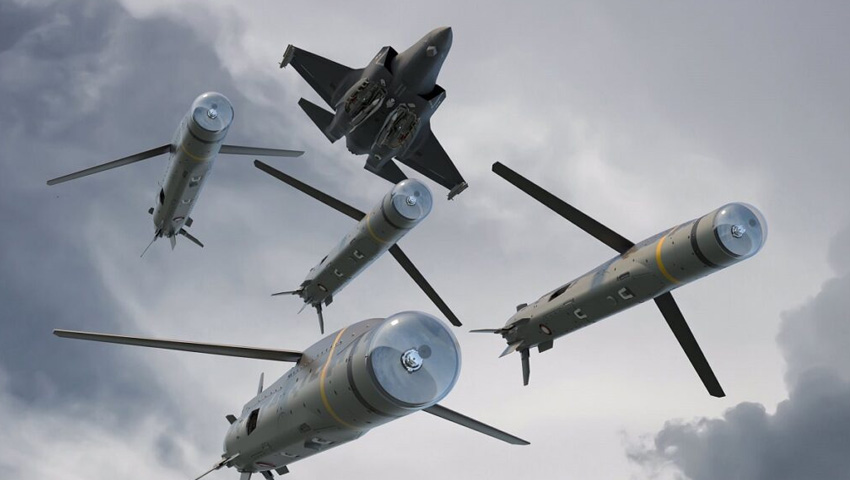The UK Royal Navy has signed a £550 million contract for new surface-attack missiles will secure hundreds of UK jobs and provide unrivalled lethality for the UK’s F-35B Lightning jets.
To continue reading the rest of this article, please log in.
Create free account to get unlimited news articles and more!
MBDA has been awarded £550 million to equip the Lightning Force – based at RAF Marham – with the new weapon, which has been developed over the past decade and will be introduced to the front line over the next seven years.
Known as SPEAR3, the next-generation missile can travel long distances at high-subsonic speed and over the next decade will become the F-35’s primary air-to-ground weapon – designed to knock out warships, tanks and armoured vehicles, missile launchers, bunkers, radar posts and air defence batteries, the new missile can be fired at such long range – more than 140 kilometres – it should keep the Navy and RAF pilots out of harm’s way from enemy ground defences.
Weighing under 90 kilograms and just 1.8 metres long, SPEAR3 – Select Precision Effects At Range missile No.3 – is powered at high subsonic speeds by a turbojet engine, can operate across land and sea, day or night, and strike at moving and stationary targets.
This ability to attack moving targets will enhance the UK’s future combat air capability and provide immense lethal capability to the Queen Elizabeth Class carrier strike group.
It will support 700 jobs in the UK – 190 of them highly-skilled technology jobs in system design, guidance control and navigation and software engineering – at sites around the country including Bristol, Stevenage and Bolton.
Testing, simulation and trials will include controlled firings from a Typhoon aircraft before the missile is delivered to Marham and the Portsmouth-based carriers for front-line operations.
UK Defence Minister Jeremy Quin said, "The development of this next-generation missile will allow us to protect our personnel and assets on the ground, from thousands of metres in the sky above. Our commitment to this system will secure hundreds of highly skilled jobs across the UK and showcase British technology and weapon expertise on the world stage."
Following a successful development phase, the new seven-year demonstration and manufacture contract with MBDA will support more than 700 UK jobs, including the creation of 190 highly skilled technology jobs in system design, guidance control and navigation and software engineering.
At the peak of the contract, 570 people will work on various aspects of the system’s development in Bristol, Stevenage and Bolton. Another 200 jobs are expected to be sustained along the supply chain that includes L3/Harris, Roband, Collins, EPS and MSB.
Colonel Martin French, DE&S’ lightweight and medium attack systems (LMAS) team leader, explained, "The placement of this contract marks the next major stage of the SPEAR3 weapon system’s development and is a result of months of detailed negotiations between MBDA and the LMAS project team.
"Building on the successes and technology achievements of the previous four years’ work with MBDA, we now enter the exciting and challenging demonstration phase where we start to prove the system against the UK’s requirements and ramp up activities to integrate this highly-capable weapon system onto the F-35B aircraft."
With its unique combination of stealth, cutting-edge radar, sensor technology, and armed with SPEAR3, the F-35 will protect aircraft carriers from enemy ships, submarines, aircraft and missiles.
The UK currently has 21 fifth-generation F-35Bs, having received three new jets on 30 November. The platform’s Initial Operating Capability (Maritime) was recently declared and, later this year, F-35 jets will sail with HMS Queen Elizabeth on her maiden Global Carrier Strike Group ‘21 deployment.
The initial demonstration phase will assess the weapon system against the UK military’s requirement through, testing, simulation and trials, which will include controlled firings from a Typhoon aircraft.
The contract forms part of the Complex Weapons portfolio with MBDA, which is on track to deliver £1.2-billion saving to UK defence, this also allows the MOD and MBDA to maximise the export potential of complex weapons, including the first-in-class SPEAR3, which supports UK prosperity and the international agenda.
The Lockheed Martin F-35 Joint Strike Fighter is billed as a catalyst for the fifth-generation revolution, changing the face and capability of the Royal Australian Air Force and the wider Australian Defence Force.
For the RAAF, the F-35A's combination of full-spectrum low-observable stealth coatings and materials, advanced radar-dispersing shaping, network-centric sensor and communications suites – combined with a lethal strike capability – means the aircraft will be the ultimate force multiplying, air-combat platform.
The F-35A – the variant chosen by the RAAF – will have with a projected life of 30 years in service.
Ten nations are currently flying F-35s, including the US, UK, Italy, Norway, Israel and Japan. The first of Australia’s F-35A aircraft are now based on home soil after a period of training and development at Luke Air Force Base in Arizona, plus an epic Pacific Ocean crossing in December 2018.
Over the coming years, Australia will purchase 72 of the advanced fifth-generation fighter aircraft as part of the $17 billion AIR 6000 Phase 2A/B program – which is aimed at replacing the ageing F/A-18A/B Classic Hornets that have been in service with the RAAF since 1985.
Stephen Kuper
Steve has an extensive career across government, defence industry and advocacy, having previously worked for cabinet ministers at both Federal and State levels.

 Login
Login








